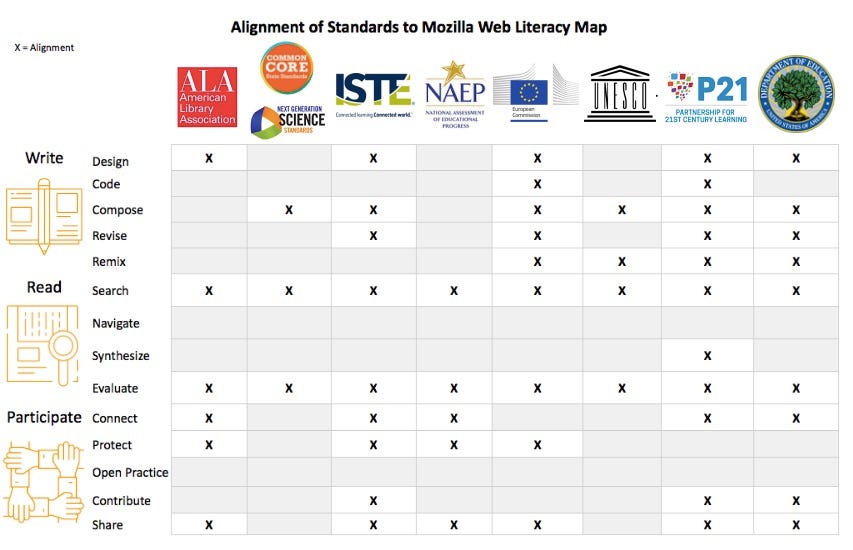p. 24
Improving Digital Literacy.
Schools are charged with developing students’ digital citizenship, ensuring mastery of responsible and appropriate technology use, including online etiquette and digital rights and responsibilities in blended and online learning settings. Due to the multitude of elements comprising digital literacy, it is a challenge for schools to implement a comprehensive and cohesive approach to embedding it in curricula.
Rethinking the Roles of Teachers.
Pre-service teacher training programs are also challenged to equip educators with digital and social–emotional competencies, such as the ability to analyze and use student data, amid other professional requirements to ensure classroom readiness.
p. 28 Improving Digital Literacy
Digital literacy spans across subjects and grades, taking a school-wide effort to embed it in curricula. This can ensure that students are empowered to adapt in a quickly changing world
Education Overview: Digital Literacy Has to Encompass More Than Social Use
What Web Literacy Skills are Missing from Learning Standards? Are current learning standards addressing the essential web literacy skills everyone should know?https://medium.com/read-write-participate/what-essential-web-skills-are-missing-from-current-learning-standards-66e1b6e99c72


The American Library Association (ALA) defines digital literacy as “the ability to use information and communication technologies to find, evaluate, create, and communicate or share information, requiring both cognitive and technical skills.” While the ALA’s definition does align to some of the skills in “Participate”, it does not specifically mention the skills related to the “Open Practice.”
The library community’s digital and information literacy standards do not specifically include the coding, revision and remixing of digital content as skills required for creating digital information. Most digital content created for the web is “dynamic,” rather than fixed, and coding and remixing skills are needed to create new content and refresh or repurpose existing content. Leaving out these critical skills ignores the fact that library professionals need to be able to build and contribute online content to the ever-changing Internet.
p. 30 Rethinking the Roles of Teachers
Teachers implementing new games and software learn alongside students, which requires
a degree of risk on the teacher’s part as they try new methods and learn what works
p. 32 Teaching Computational Thinking
p. 36 Sustaining Innovation through Leadership Changes
shift the role of teachers from depositors of knowledge to mentors working alongside students;
p. 38 Important Developments in Educational Technology for K–12 Education
Consumer technologies are tools created for recreational and professional purposes and were not designed, at least initially, for educational use — though they may serve well as learning aids and be quite adaptable for use in schools.
Drones > Real-Time Communication Tools > Robotics > Wearable Technology
Digital strategies are not so much technologies as they are ways of using devices and software to enrich teaching and learning, whether inside or outside the classroom.
> Games and Gamification > Location Intelligence > Makerspaces > Preservation and Conservation Technologies
Enabling technologies are those technologies that have the potential to transform what we expect of our devices and tools. The link to learning in this category is less easy to make, but this group of technologies is where substantive technological innovation begins to be visible. Enabling technologies expand the reach of our tools, making them more capable and useful
Affective Computing > Analytics Technologies > Artificial Intelligence > Dynamic Spectrum and TV White Spaces > Electrovibration > Flexible Displays > Mesh Networks > Mobile Broadband > Natural User Interfaces > Near Field Communication > Next Generation Batteries > Open Hardware > Software-Defined Networking > Speech-to-Speech Translation > Virtual Assistants > Wireless Powe
Internet technologies include techniques and essential infrastructure that help to make the technologies underlying how we interact with the network more transparent, less obtrusive, and easier to use.
Bibliometrics and Citation Technologies > Blockchain > Digital Scholarship Technologies > Internet of Things > Syndication Tools
Learning technologies include both tools and resources developed expressly for the education sector, as well as pathways of development that may include tools adapted from other purposes that are matched with strategies to make them useful for learning.
Adaptive Learning Technologies > Microlearning Technologies > Mobile Learning > Online Learning > Virtual and Remote Laboratories
Social media technologies could have been subsumed under the consumer technology category, but they have become so ever-present and so widely used in every part of society that they have been elevated to their own category.
Crowdsourcing > Online Identity > Social Networks > Virtual Worlds
Visualization technologies run the gamut from simple infographics to complex forms of visual data analysis
3D Printing > GIS/Mapping > Information Visualization > Mixed Reality > Virtual Reality
p. 46 Virtual Reality

